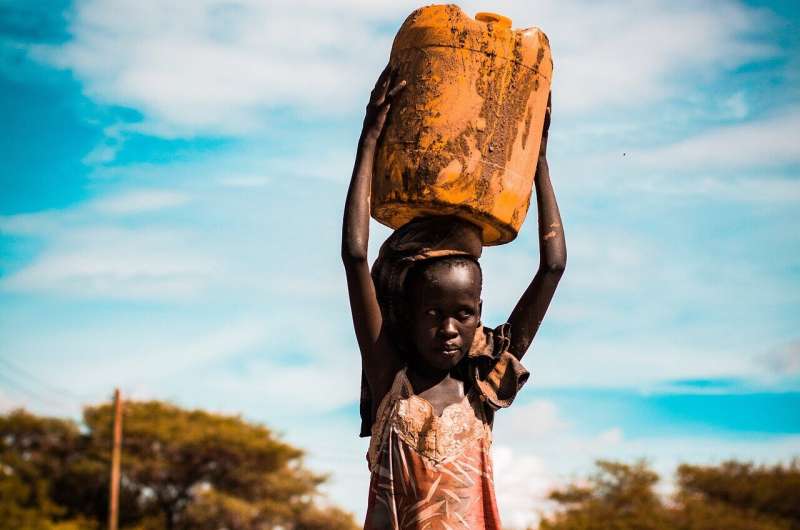This article has been reviewed according to Science X's editorial process and policies. Editors have highlighted the following attributes while ensuring the content's credibility:
fact-checked
trusted source
proofread
Extreme weather events linked to increased child marriage

Among the negative impacts of extreme weather events around the world is one that most people may not think of: an increase in child marriages.
Researchers at The Ohio State University conducted a systematic review of 20 studies connecting droughts, floods and other extreme weather events to increases in child, early and forced marriages in low- and middle-income countries.
Overall, the studies provide compelling evidence of the problem, said Fiona Doherty, lead author of the study and a doctoral candidate in social work at Ohio State.
It's not that extreme weather has a direct effect on child marriages, Doherty said.
"What these disasters do is exacerbate existing problems of gender inequality and poverty that lead families to child marriage as a coping mechanism," she said.
The study was published recently in the journal International Social Work.
Globally, one in five girls is married before the age of 18, and in lower- and middle-income countries that number rises to 40%.
Those numbers may grow as climate change increases the frequency of extreme weather events around the world, said study co-author Smitha Rao, assistant professor of social work at Ohio State.
"The complexities surrounding child marriage and extreme weather will worsen amid climate change," Rao said.
The researchers examined 20 studies published between 1990 and 2022 that examined how extreme weather was related to marriages involving children, mostly girls, who were below the age of 18. Most of the studies were done in low- and middle-income countries in Asia and Africa, including Bangladesh, India, Pakistan, Kenya, Nepal and Vietnam.
Droughts and floods were the most common disasters, but other studies looked at the impact of cyclones and high temperature shocks, among other weather events.
The studies revealed the impacts of disasters on child marriage in a variety of contexts, Doherty said.
One study in Bangladesh found that in years with heat waves lasting more than 30 days, 11- to 14-year-old girls were 50% more likely to marry and girls aged 15–17 were 30% more likely.
A major reason is simply economics.
"Child marriage is often seen as a coping strategy to reduce economic vulnerability and food insecurity that a family is facing because of a disaster," Doherty said.
For example, one study found that daughters were married early in Bangladesh after Cyclone Aila to curtail the economic and food burden on households.
Early marriage was also sometimes encouraged to provide needed workers for families.
When a drought threatened water sources and livestock in Kenya, one study found that young brides were sought to help with increased labor demands, such as walking long distances to find food and water.
Regional customs such as bride price and dowry were found to be key factors in the link between child marriage and extreme weather.
In areas such as sub-Saharan Africa and Vietnam that practice bride price—the groom's family pays the bride's family—girls had an increased probability of being forced to marry during droughts and periods of heavy rainfall, studies showed.
In contrast, research found that in regions like India where dowry is common—the bride's family pay the groom's family—girls were less likely to get married during a drought year, likely because the bride's family could not afford dowry payment.
Beyond economics, studies showed a variety of ripple effects from weather disasters that led to more child marriages, Rao said.
Communities that were displaced by floods, cyclones and other disasters often ended up in camps where young girls were targeted for sexual harassment and violence.
"Families sometimes made the choice to get their young daughters married off in these situations to protect them from harassment and sexual violence," Rao said.
But there was one key factor that helped protect children from being forced to get married.
"We found that education played a significant role in protecting girls," Doherty said.
Girls who were educated were less likely to be married off early, research found. In addition, studies showed that as parental education increased, they were less likely to marry off their daughters.
While education is one way to help protect against child marriage, Doherty and Rao said more needs to be done. One obvious choice would be laws against child marriage. Another factor is helping families with the economic difficulties that often lead to them marrying off daughters.
"But we found the main driver of child marriage is gender inequality," Doherty said. "We need to find ways to empower women and girls with education and financial control that will allow them to make their own decisions."
The researchers noted that all of the studies they analyzed were done in low- and middle-income countries—only because they could not find any studies done in high-income countries.
But weather disasters could also be increasing child marriage in high-income countries, including the United States, they said.
"We need more research to understand the differences and additional factors that may be affecting the link between extreme weather events and child marriage in other parts of the world, including high-income countries," Rao said.
More information: Fiona C Doherty et al, Association between child, early, and forced marriage and extreme weather events: A mixed-methods systematic review, International Social Work (2023). DOI: 10.1177/00208728231186006
Provided by The Ohio State University




















